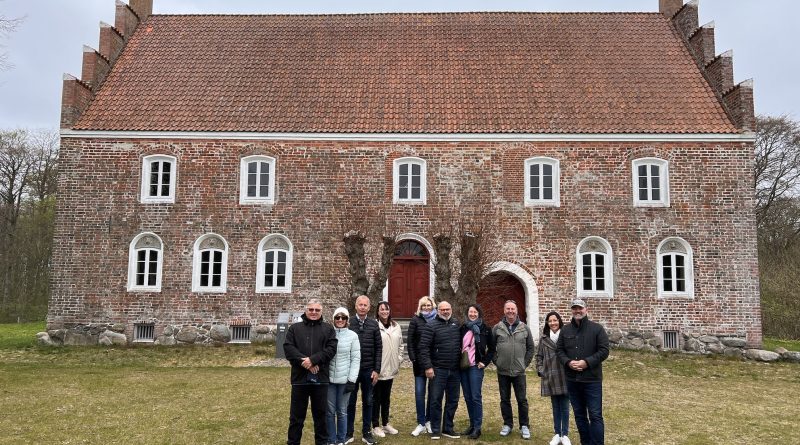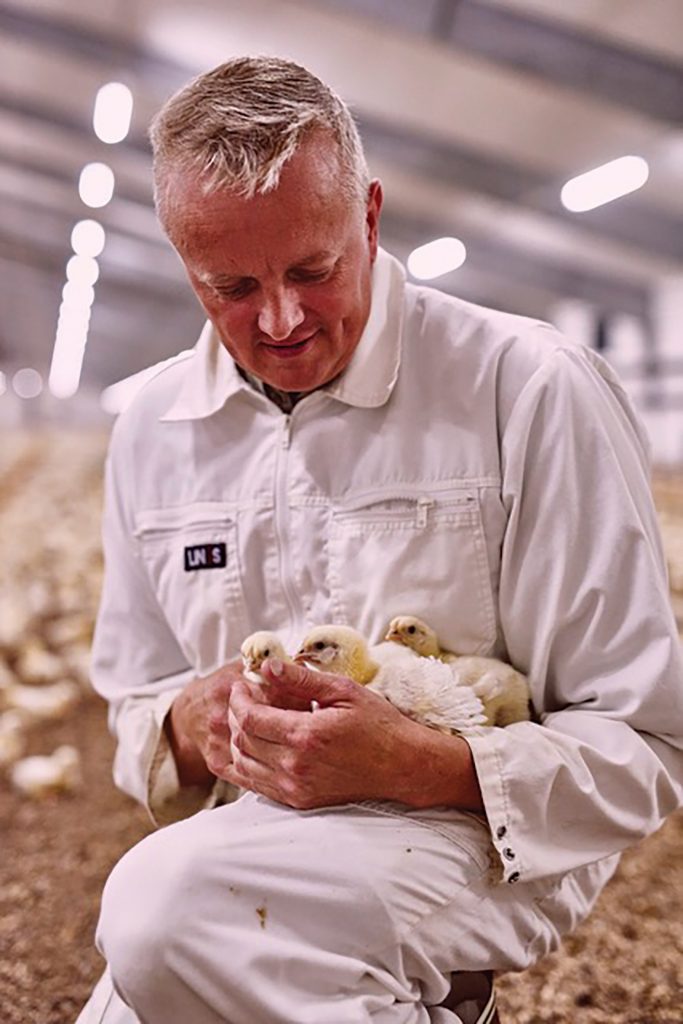SKOV hosts Australian delegation in Denmark
By Peter Bedwell
During April, a delegation from Australia visited the headquarters of SKOV in Glyngore, Denmark.
SKOV’s Sales Manager Arne Overgaard was hosting the guests and he had planned a program that included a farm visit to the slow grow production poultry farm in Agardsholm, belonging to Rasmus Skov, the grandson of one of the founders of SKOV.
Another visit was planned for the Danish broiler producer Frijsenborg.
The delegation also listened to various presentations from some of the company’s climate, production and poultry specialists.
Amongst the visiting Australian contingent were Luke Trevanion and Tony Young from Santrev, Luigi Di Clemente from Farmmark and Bill
Williams, CEO of Proten and James Wentworth, CFO of Proten.
“SKOV contributes to efficient and sustainable global food production that delivers healthy food produced in respect to animal welfare.
“We provide climate solutions, farm management, and digital value chain services for animal production worldwide,” said Tommy Krogh, Business Development Manager – Poultry Specialist with SKOV.
Apart from the headquarters in Denmark, SKOV has subsidiary companies in Thailand, Russia, China, and the United States, and a software development department in Malaysia. The SKOV group also includes Secco International Inc. in Canada.
The headquarters has expanded on several occasions and today, there is in excess of 16,000 m² under one roof.
“The next landmark on the timeline will be when we put a new logistics centre into operation. It covers an area of another 16,000 m2.
“The new logistics centre brings together the warehouse in Denmark at one location close to our local subcontractors.
It features cutting-edge technology to optimise the work processes and thus facilitates the distribution of our ventilation solutions worldwide at competitive prices.
“Having been present in the market since 1966, SKOV has become one of the world’s leading suppliers of ventilation and farm management systems and counts more than 500 employees.”
In the middle of the 1960s, the brothers Kristen and Kjeld Skov developed the first ventilation system and ran the largest egg production facility in Scandinavia at the old manor house of Oestergaard Hovedgaard.
The idea of a ventilation system was born out of the connection with the
construction of two new livestock houses. The brothers could not locate a system with the capacity to ventilate houses of the envisioned magnitude, so they set about developing ventilation systems themselves.
The sale of ventilation solutions for poultry and pig houses began in 1966, thus establishing the foundation of today’s SKOV.
Ventilation systems manufactured by the brothers quickly gained popularity, and owing to lack of space, they built a new factory in Glyngoere in 1978.
In 1982, the export adventure began to pick up speed with some huge orders to Northern Africa, and since then, new systems and products have been developed and exported worldwide.
Today, the company is a world leader in its field, and export accounts for more than 90% of the turnover.
The first visit to the farm belonging to Rasmus Skov allowed the Australian contingent to experience the methods for slow growing birds. The farm has only recently converted to slower growth genetics.
The farm consists of two houses made of sandwich construction with 50,000 slow growing broilers in each house.
Tommy Krogh, SKOV’s climate and poultry production specialist revealed to Poultry
Digest the specific SKOV equipment used on the RASMUS farm includes:-
• DA 1200 inlets and DA 600 outlets
• DOL 539 controller and DOL 2400 alarm system
• High-pressure cooling and Spiraflex heating
• SKOV production equipment
• Rokkedahl Heat exchanger
“The fact that the farm uses a slow growing method is now typical of Danish poultry farms where 60% of poultry consumption in Denmark
consists of slow growing birds,” Tommy told Poultry Digest.
Rasmus Skov explained to the visitors “that the hatching of the birds is done inside the sheds”.
“The 53,000 eggs are purchased and placed directly into the sheds where they hatch and grow to maturity.
“He explained that the expected rate of hatching is around 95% and the floor is heated to 31 degrees C using under floor hot water.
“That’s something we may have to reconsider in Australia,” said Luke Trevanion from Santrev.
“With the current price of LPG in Australia it might be an alternative cheaper source of heating.”
“The birds bedding is made of grass pellets spread on top of the concrete flooring,” Luke also mentioned.
Given the rising cost of bedding material like wood shavings or rice hulls in Australia and the difficulty some growers here are experiencing is disposing of spent litter, the use alternatives like grass based bedding may be worth considering.
In markets like the US where traditionally litter is not cleared out after each batch there has been a move to grass based litter.
One of the reasons for this, apart from the cost of other bedding materials is the move to drastically reduce antibiotic use.
To assist in the move to AB reduction or removal from poultry production there is a greater need to remove litter more frequently.
This also applies to many European market. Research conducted by North Carolina State University has identified a number of grass species that are suitable for use in poultry bedding. Switchgrass, Bermuda grass and Miscanthus grass have been trialled as bedding materials for broilers and turkeys.
“The second farm visit was to Frijsenborg Agriculture in Hammel where the poultry is reared in 24 houses on six different locations,” Tommy told Poultry Digest.
“They use much of the same SKOV equipment as on the Rasmus Skov farm and the sheds vary in size from 19,000 to 60,000 birds.
“The broiler birds have access to an open area attached to some of the houses which you could identify as a ‘Winter Garden’ or Veranda housing system,” Tommy said.
The Frijsenborg operation is a part owner of Danhatch Special breeds, producing the Ranger Gold genetics and on this farm they have three units dedicated to rearing parent stock.
“Other critical infrastructure includes a biogas production plant, utilising over 250,000 tonnes of poultry waste per annum.
“There is also other farming activity on 3,000 hectares of land and there is 7,000 hectares of forest attached to the broiler rearing operations
“In between farm visits the contingent from Australia attended the SKOV headquarters and were informed about all the latest developments at our company,” Tommy concluded.
The specific SKOV equipment used on both farms includes:-
DA 1200 wall inlets providing fresh air to the livestock house which provide a good uniform climate all over the house, even at minimum ventilation.
The outside air is directed toward the ceiling of the house and mixed with the existing air before it reaches the zone occupied by animals.
This method does not cause any draughts and thus leads to uniform distribution of animals and thereby the same growth conditions for all.
During hot periods, a higher air velocity can provide a cooling effect for the animals.
DA 1200 bricked-in wall inlet is suitable for sandwich board shed walls and available for various thickness specifications.
The inlets require no additional support in connection with bricking in or fixing inlets in walls.
The DA 1200 inlet system delivers
• Uniform climate all over the house
• Inlets close tightly – no draught or false air intake
• Fully insulated – no condensation or ice formation
• Operated by a pull rod – all inlets maintain the adjusted opening degree
• Maintenance-free and long
durability
DA 600 is a robust and efficient exhaust unit. These aerodynamic chimneys are developed for maximum air output at low energy consumption levels.
The chimneys are particularly robust under all weather conditions and have a very long service life. They are custom-fit to the building and can be used on virtually any type of livestock house.
They can be adjusted to fit the roof pitch of individual buildings, colour and placement.
The LPC fans are a series of energy-efficient fans that are particularly suitable for ventilation of livestock houses and optimised to work with SKOV’s ventilation systems and chimneys.
An LPC fan has a high level of
pressure stability, and it is less sensitive to wind, they deliver,
• Aerodynamic and optimized to the LPC fan
• Maximum air output at low energy consumption
• Robust under all weather conditions
• Profiled roofing sheets – no need for sealing
• Side or ridge-mounted – easily adapted to the roof
• DOL 2300/2400 alarm can be ON/OFF or temperature-controlled
• DOL 2400 alarm system can monitor the temperature of up to 100 houses and can also be used to warn of equipment faults and other emergencies.
• The alarm system includes advanced temperature monitoring with temperature compensation.
It can also receive analog input from capacitive sensors and generate an alarm if the silo level is too low or the water consumption has changed.
• The alarm system can generate silent alarms, general alarms, and local alarms such as sirens, flashing lights, and loudspeakers. In addition, you can receive a phone call and a text.
The Spiraflex finned tube heating system is based on the supply and circulation of hot water and maintains high productivity during the cold periods.
Using finned tubes to heat livestock houses, you get an efficient and quickly responding heating system, ensuring an optimal climate for the animals.
SKOV heating components are of very high quality and are well suited for a harsh livestock house environment.
The heat emission level of the Spiraflex tube is, per meter, much higher than the heat emission of a smooth tube.
The tubes are mounted below the air inlets. The positioning helps provide correct ventilation with optimum mixing of cold air from the outside and heated housing air so that the animals are not exposed to cold air downdraughts.
The benefits include:
• An optimum environment as the system does not add CO2 to the air
• Optimises the air distribution at minimum ventilation – same good climate for all animals
• Finned tubes provide efficient and cost-effective heating of the air in the house
• Fully welded finned tubes, which ensure a high, documented heat output
They are easy to install with stainless splicing sleeves, and you do not need any tools or equipment
The SKOV 539 controller delivers:-
• Flexible solution of software and hardware
• Climate regulation is based on temperature and humidity, but also the CO2 and NH3 level
• Precise climate control – optimal growth condition for all poultry in the house
• Adaptive Control – artificial intelligence to secure higher productivity and animal welfare
• Dynamic MultiStep – low energy consumption and optimal climate
A SKOV controller controls the climate and production at house level.
FarmOnline shows photos and drawings of the farm, providing a high level of graphic recognisability and quick navigation. The program displays selected key values for temperature, humidity, ventilation, cooling, and heating through user-friendly graphic elements, and you can change settings directly.
All essential production data is displayed on one screen – providing a quick overview and enabling in-depth analyses. As both current and historical data is displayed for mortality, weight, and feed consumption, it is possible to monitor the development of the individual batches and compare them to each other.
The farms visited by SKOV’s Australian guests operate in very different conditions to down under.
But the common aspects faced by both Danish and Australian broiler production are high energy costs, pressure from consumers to produce slow growing birds, litter use/disposal and the critical need to reduce feed costs while extracting maximum benefit from available genetics.

